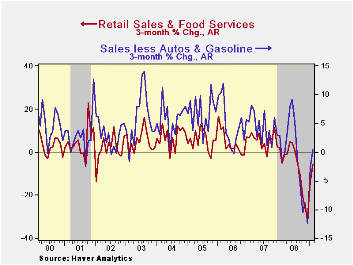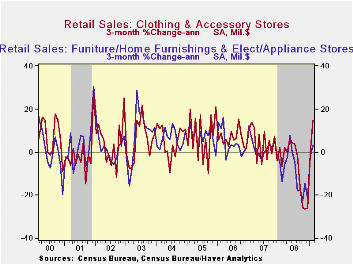 Global| Mar 12 2009
Global| Mar 12 2009U.S. Retail Sales Excluding Autos Rise; Revisions Sharply Higher
by:Tom Moeller
|in:Economy in Brief
Summary
Consumer spending firmed in the last two months following the notably soft performance during the second half of last year. During February, retail sales excluding autos & gasoline rose 0.5% after a 1.4% January increase which was [...]

Consumer spending firmed in the last two months following the notably soft performance during the second half of last year. During February, retail sales excluding autos & gasoline rose 0.5% after a 1.4% January increase which was nearly double the gain reported initially.
Overall, retail sales slipped 0.1% in February and that was not far off expectations for a 0.5% decline. However, coupled with a sharp upward revision to the January increase to 1.8% from 1.0%, it left sales for the start of 2009 on a much firmer footing. Consensus expectations had been for a decline of 0.5% in the February sales total. The retail sales data are available in Haver's USECON database.
The rise in total sales came despite another shortfall in motor vehicle purchases. They fell 4.3% and that mirrored the 4.7% m/m drop in unit sales of light vehicles which was reported last week. Gasoline service station sales offset some of that downside surprise. They rose 3.4% (-32.3% y/y) though the gain was boosted by the latest increases in gas prices.
Rebounds in sales were widely evident in this month's report.
Sales at furniture, electronics & appliance stores added 0.9%
to the upwardly revised 3.5% surge during January (6.1% y/y). Furniture
store sales rose for the first month since last April and posted a 0.7%
increase (-10.7% y/y). Sales of electronics & appliances added
1.2% (-1.4% y/y) to their 7.5% January upward spurt.
In the soft goods area, apparel store sales added 2.8% (-3.1% y/y) to the upwardly revised 4.9% January gain. At general merchandise stores, sales rose another 1.3% (2.3% y/y) on top of the unrevised 1.1% January increase.Last year apparel store sales fell 9.9% December-to-December and merchandise store sales slipped 0.2%.
Sales at nonstore (internet) retailers have not shared the picture of upside surprise. They rose just 0.3% last month (-0.6% y/y) after a 1.7% January increase which was downwardly revised. Moreover, the interest in dining out slackened and sales fell 0.2% (+2.8% y/y) after a 1.8% January increase.
Building materials sales continued down and posted a 0.2% (-10.3% y/y) decline. It was the seventh consecutive monthly drop.
Detecting Recessions in the Great Moderation: A Real-Time Analysis from the Federal Reserve Bank of Kansas City is available here.
| February | January | December | Y/Y | 2008 | 2007 | 2006 | |
|---|---|---|---|---|---|---|---|
| Retail Sales & Food Services (%) | -0.1 | 1.8 | -3.1 | -8.6 | -0.4 | 4.2 | 5.8 |
| Excluding Autos | 0.7 | 1.6 | -3.2 | -5.0 | 2.8 | 4.6 | 6.8 |
| Less Gasoline | 0.5 | 1.4 | -1.8 | -0.6 | 1.8 | 4.2 | 6.2 |
Tom Moeller
AuthorMore in Author Profile »Prior to joining Haver Analytics in 2000, Mr. Moeller worked as the Economist at Chancellor Capital Management from 1985 to 1999. There, he developed comprehensive economic forecasts and interpreted economic data for equity and fixed income portfolio managers. Also at Chancellor, Mr. Moeller worked as an equity analyst and was responsible for researching and rating companies in the economically sensitive automobile and housing industries for investment in Chancellor’s equity portfolio. Prior to joining Chancellor, Mr. Moeller was an Economist at Citibank from 1979 to 1984. He also analyzed pricing behavior in the metals industry for the Council on Wage and Price Stability in Washington, D.C. In 1999, Mr. Moeller received the award for most accurate forecast from the Forecasters' Club of New York. From 1990 to 1992 he was President of the New York Association for Business Economists. Mr. Moeller earned an M.B.A. in Finance from Fordham University, where he graduated in 1987. He holds a Bachelor of Arts in Economics from George Washington University.






